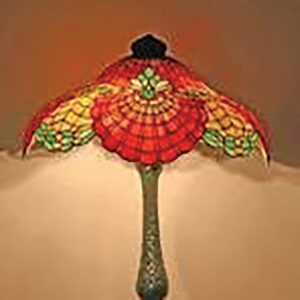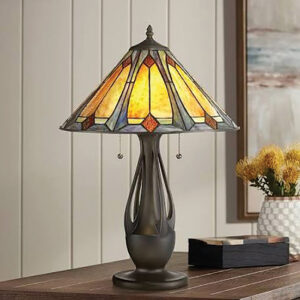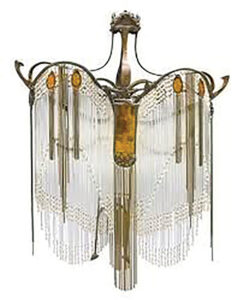 By Robert Reed
By Robert Reed The beauty of Art Nouveau and the amazing light of electricity arrived at nearly the same time in the twilight of one century and the dawn of still another.
“Nouveau was flowing, growing lines of vines and trailing flowers,” wrote Jean Minar Paris. “It was foliage that grew across page and wall, from chair leg to table top, and wound around the necks and wrists of beautifully adorned ladies in unsurpassed creatively designed jewelry.”
And both the light and the art of the era flowed from the lamps of Art Nouveau.
Art Nouveau shown brightly in Europe and finally in the United States from the 1890s until the outbreak of World War I. The progressive decorative style was largely bounded by curved lines and based on natural forms.
While it was apparently introduced at the Paris shop of Samuel Bing in 1895, it was a style that was soon warmly welcomed elsewhere. In Austria the style was called Sezessionstil, in Germany it was Jugendstil or youth style, in Spain it was simply Modernista, and In Italy it was style Liberty after the English department stores which so heavily promoted it.
It was still clearly identified as Art Nouveau in the United States, but the focus was largely limited to glass and lamps.
“As a movement, Art Nouveau in American became a style of ornamentation,” notes John S. Bowman the author of American Furniture, “essentially confined to areas other than furniture. Relatively few pieces of furniture were made, and yet Louis Comfort Tiffany’s glass and glass lampshades received international acclaim.”
 For a country that had both Tiffany and technology, it followed that one of the mainstays of the art here would be lovely lamps.
For a country that had both Tiffany and technology, it followed that one of the mainstays of the art here would be lovely lamps.“The invention and use of electricity opened a whole new world for lamp designers in the later days of the 19th century when Art Nouveau was at its height in America,” points out the Field Guide to Antiques and Collectibles.
“Bulbs could face up or down, and sideways and could be designed as a flame, rose, or animal. Anything. Anyway. They could be hidden behind seashells and under beads, with fringe and with art glass shades or silk.”
Of course not all Art Nouveau lamps were strictly electrical ones. As Nadja Maril points out in American Lighting 1840 to 1940, combination gas and electric fixtures were made in every variation of style, and some included lead glass and featured “trailing leaves and flower-shaped shades, as well as traditional brass.”
But it was the Edison inspired electric lamp that was truly designed as a work of art according to Maril:
“Using nature as a model, the base of a lamp was often in the form of a flower stem or tree trunk and the shade represented the flower petals. In many instances bulbs were left bare, representing flower buds.”
As early as the 1880s Thomas Edison had produced a pear-shaped bulb as part of his 16-candle-power lamp. The beaming bulbs could be pointed in different directions to highlight the shade or become a part of the whole image.
In 1910 the Sears, Roebuck and Company home builder’s catalog featured a few electrical lamps under the heading, “latest designs in L’Art Nouveau leaded glass.” The Tulip, for example, came with an art glass shade, brass base, and Edison chain pull socket. It stood 22 inches high and sold for $9.95.
 Edison and Tiffany worked together as early as the 1880s on the interior designs of such New York showplaces as the Madison Square Theater and the Lyceum Theater.
Edison and Tiffany worked together as early as the 1880s on the interior designs of such New York showplaces as the Madison Square Theater and the Lyceum Theater. From there Tiffany pressed on to become, in the opinion of the National Museum of American Art in Washington, D.C., “America’s most brilliant, extravagant design and decorative artist of the late Victorian and Edwardian eras.”
Some art historians note that Tiffany was inspired by European artists and designers of the Art Nouveau era, but he added a very individualistic emphasis on nature and naturalism based on his own background.
“Tiffany created iridescent glass of extraordinary beauty,” observes The Encyclopedia of Antiques by Arthur Negus. “Those patterns of peacock feathers, tulips, lilies, and dragonflies so perfectly fit the asymmetrical yet natural lines of Art Nouveau.”
His dragonfly lamp combined Japanese art with lavishly colored glass, and his Wisteria lead-glass table lamp imitated the flower and vine of the Wisteria plant.
At its peak between early 1900 and 1917, Tiffany Studios employed some 200 artists and artisans, paying some of them as much as $10,000 annually to produce fine works including lamps.
The quality and the wages made Tiffany lamps expensive. His Wiesteria lamp, for example, retailed for $400 at a time when the average working wage was $8 to $10 per week.
However those who couldn’t afford true Tiffany lamps had dozens of other options including lamps with the far less expensive panel glass applied to them.
Others producing wonderful Art Nouveau lamps of the period included Handel and Company of Connecticut, Quezal Art Glass and Decorating Company of New York, Fostoria Glass Specialty Company of Ohio, and the Steuben Glass Company in New York—among others.
Eventually mail-order catalog companies were able to offer trim and attractive lamps in the ‘modern’ style for around a week’s pay.
Historically and artistically the age of Art Nouveau proved to be one of the most creative and productive. There were lamps in America, furniture in Europe, bronzes and jewelry everywhere and eventually “even automobiles were designed within the realm of its dictates,” according to Schroeder’s Antiques Price Guide.
“Today’s market abounds with lovely examples of Art Nouveau,” they conclude in their report, “allowing the collector to choose one or several areas that hold a special interest.”















Follow Us